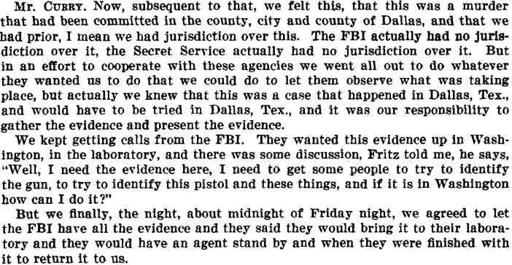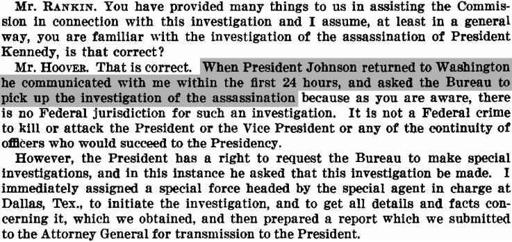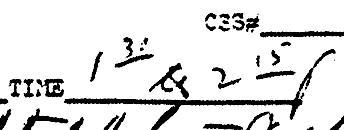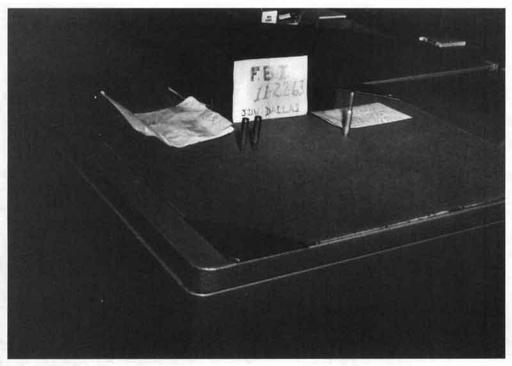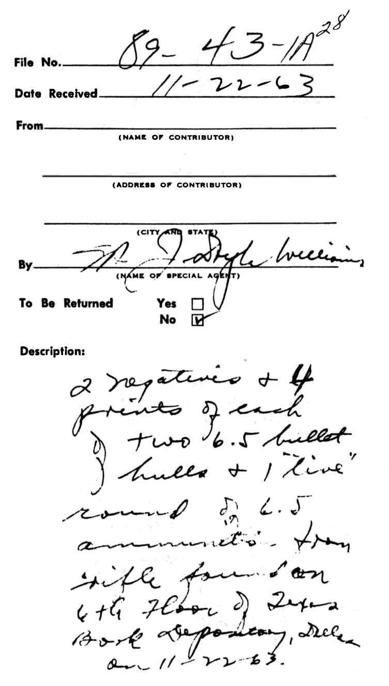Impossible: The Case Against Lee Harvey Oswald (37 page)
Read Impossible: The Case Against Lee Harvey Oswald Online
Authors: Barry Krusch
Tags: #Non-Fiction, #History

BOOK: Impossible: The Case Against Lee Harvey Oswald
11.16Mb size Format: txt, pdf, ePub
. . . the transfer of possession of ballistic evidence to the FBI would have been an extraordinary anomaly. Why? Because the Dallas Police Department
alone
had jurisdiction over the case, and the FBI had
none
, as shown by this exchange between FBI Director J. Edgar Hoover and Warren Commission Chairman Earl Warren on May 14, 1964 (5 H 115):
21
Dallas Police Chief Jesse Curry discussed this aspect of the case with the Commission on April 22 1964, relating a conversation between himself and Captain John Will Fritz of the Dallas Police Department (4 H 195):
22
And so the FBI was provided the evidence, apparently because this was a “special investigation” called for by President Johnson according to Director Hoover in that same testimony (5 H 98):
23
According to Hoover, though, this so-called “special investigation” was not requested by Johnson until
after
Johnson returned to Washington (“When President Johnson returned to Washington . . .”). This statement conforms with the facts, since Johnson would not have called for this special investigation any earlier. In the first place, Johnson had not been informed that President Kennedy had died until
1:10 p.m.
CST (RH75), and until that time could not have been certain that he would be President. Then, Johnson remained at Parkland Hospital until
1:40 p.m.
CST, after which he departed for Air Force One at Love Field, where he was sworn in as President at
2:38 p.m
CST. After the swearing-in ceremony, he was flown to Andrews Air Force Base, located approximately 10 miles southeast of Washington DC (in Prince George’s County, Maryland), where he arrived at approximately
5:00 p.m
CST.
24
He was then flown by helicopter to the White House, when he touched down at
5:26 pm
CST (RH 144). In this whirlwind of a day, Johnson was obviously too preoccupied to call Hoover, and so when Hoover tells us that Johnson contacted him
after
5:26 p.m.
CST, we can believe him.
And there’s the rub: the FBI had no jurisdiction over the case, and the normal Dallas police procedure would have been to turn over the evidence to personnel at the Crime Scene Search Section of the Dallas Identification Bureau (for example, an FBI agent at Parkland Memorial Hospital refused to accept a bullet found on a stretcher by a Parkland employee; see discussion at RH 84, Paragraph 2 re: CE 399).
But here this procedure was violated. An order essentially re-designating jurisdiction had supposedly been given, but that order could not have been given
any earlier
than 5:26 p.m, or more likely, 6:00 pm CST. And yet, when we look at the time that the shells were handed over to Brown of the FBI, we can see that the time of the handoff was much earlier, at the outside around
2:15 p.m.
CST:
25
This means that approximately
5 hours
before the earliest time Johnson could have given the order to Hoover that the FBI should take command of the investigation, the FBI had
already moved in
to take possession of the evidence!
The question now is,
who
gave that order? We know it wasn’t
Johnson
, and from a legal perspective it couldn’t have been
Hoover
, the head of the FBI reporting to Johnson (and to whom Brown ultimately reported), because Hoover tells us in his testimony that he didn’t give any such order until after “President Johnson returned to Washington,” which was at 5:26 pm CST.
So if Johnson didn’t give the order, and Hoover didn’t give it,
who did
? Who, only one hour after the death of the President, would have had the authority to take an action of this nature on their own, absent specific orders, and in violation of the code within which State and Federal criminal investigations operated, and more importantly, who could have
anticipated
this direction, given that it was not decided much later by those in charge? It is critical to note that this handoff had to consist of
coordinated edicts
, one by the head of the Dallas Police Department, and one by the head of the Federal Bureau of investigation — this could only be a
bilateral
, not a
unilateral
decision — and we know by the April 22 testimony of Curry that this was an agreement not easily arrived at, an agreement that took literally hours to achieve. So, well before this agreement was in fact achieved, who could have convinced Day and Studebaker to hand over the Evidence of the Century to those outside the scope of legitimate authority when no such edicts were given and the President’s death was announced just an
hour
earlier?
Now
that’s
a continuity error!
Maybe we can’t see the rat yet, but we sure can smell it, and by the smell we can be fairly sure it’s a big one. Let’s carry on with the story and see where the scent takes us.
After Brown (and supposedly Drain) had received the envelope with the 2 spent hulls and the live round, those items were sent to Special Agent (SA) J. Doyle Williams of the Dallas FBI Office, who made a photograph of this evidence (and whose initials appear on the identification card on the table) (
Bloody Treason
, p. 111):
26
A cover sheet prepared for the photograph tells us that what we are seeing is no optical illusion: there are only “two 6.5” hulls in the very first dated and identified photograph taken of the empty shells, as stated in the 3rd line of the description in this photograph (
Bloody Treason
, p. 110):
27
Photographer Williams dictated a memorandum on November 23 detailing the photographic session of November 22, which was released by the government many months after the Warren Commission report was issued (CD 5, p. 169):
28
Other books
Sybil Disobedience by Paulin, Brynn
Unable to Resist by Cassie Graham
Get a Grip (Hollywood Nights) by North, Cara
Painting Naked (Macmillan New Writing) by Dana, Maggie
Illeanna by Dixie Lynn Dwyer
Terror in East Lansing: The Tale of MSU Serial Killer Donald Miller by R. Barri Flowers
Ash Wednesday by Ralph McInerny
Beat the Reaper: A Novel by Josh Bazell
The Pantheon by Amy Leigh Strickland
The Searcher by Christopher Morgan Jones

